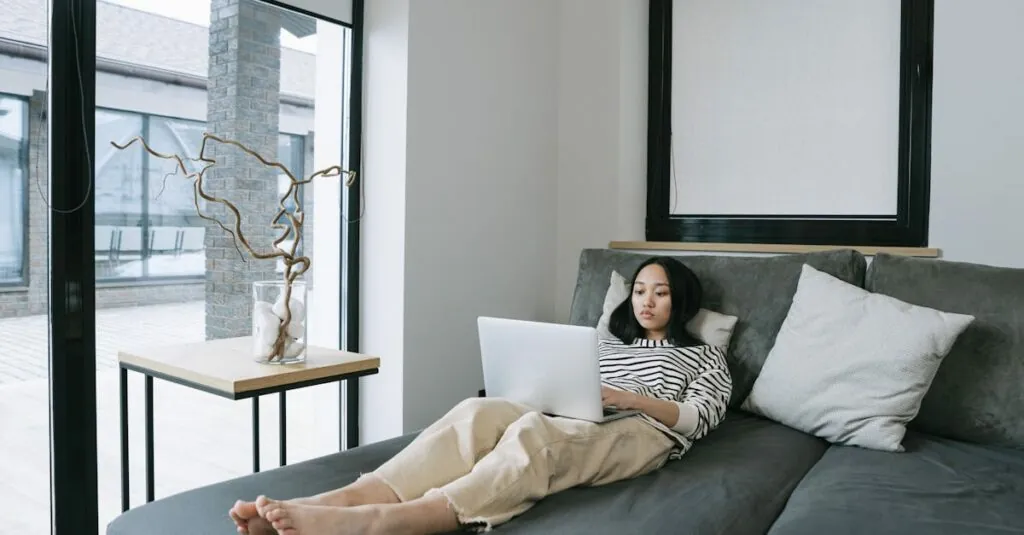In a world overflowing with clutter and chaos, the minimalist living room stands as a serene oasis. It’s not just about fewer items; it’s about creating a space that breathes, allowing both the mind and the eye to relax. Imagine a room where you can actually find your remote without a treasure hunt—sounds dreamy, right?
Table of Contents
ToggleWhat Is a Minimalist Living Room?
A minimalist living room emphasizes simplicity and functionality. This space prioritizes fewer but essential furnishings, creating an atmosphere of calm and organization. Minimalism encourages the use of neutral colors, clean lines, and natural materials to foster a serene environment.
In a well-designed minimalist living room, each item has a purpose, reducing visual clutter. Furniture pieces are often multi-functional, providing storage while maintaining a sleek aesthetic. Natural light plays a crucial role, with large windows and unobstructed views enhancing the airy feel of the room.
Decorative elements remain minimal yet meaningful. Artwork or plants can add personality without overwhelming the space. Accessories blend seamlessly into the overall design, emphasizing quality over quantity.
Maintaining a minimalist living room involves regularly evaluating belongings to ensure they align with this philosophy. Items that no longer serve a purpose or contribute to the ambiance should be removed. Embracing a minimalist mindset promotes mindfulness and intentionality in the living space.
Overall, a minimalist living room is designed to create an inviting and peaceful environment while promoting relaxation and clear thinking. Prioritizing functionality and simplicity leads to a space where everyday objects are easy to locate, enhancing daily living experiences.
Key Characteristics of Minimalist Design
Minimalist design focuses on clarity and purpose in living spaces. It emphasizes essential elements to create a serene atmosphere.
Simplicity in Furniture Selection
Furniture selection involves prioritizing pieces that serve multiple functions. Lounge chairs and coffee tables should enhance usability without overwhelming the space. Minimalistic furniture often features clean lines and lacks excessive ornamentation. Each item must contribute to the overall tranquility of the room, ensuring comfort and style. Fewer but well-chosen items transform the living space, making it both inviting and practical.
Neutral Color Palettes
Neutral color palettes establish harmony within a minimalist living room. Shades of white, beige, and gray promote a calming effect, allowing other design elements to stand out. Each hue should complement natural light, further enhancing the room’s openness. Accent colors may appear in small doses through decor, creating interest without clutter. These palettes foster a cohesive and timeless aesthetic while allowing personal touches.
Functionality and Openness
Functionality remains at the forefront of minimalist design. Spaces should feel open and airy, prioritizing accessibility. Furniture arrangement must facilitate movement while maintaining distinct areas for different activities. Open layouts encourage interaction, creating a welcoming environment. Incorporating storage solutions helps minimize visible clutter, enhancing the overall functionality of the space.
Benefits of a Minimalist Living Room
A minimalist living room provides several advantages that enhance daily living. Clarity and simplicity create a calming atmosphere, which helps individuals unwind after a long day.
Enhanced Relaxation
Reduced clutter directly contributes to enhanced relaxation. An open space allows for easier movement and encourages a sense of freedom. Natural materials used in minimalist design promote a connection to nature, fostering tranquility. Serenity comes from neutral color palettes that soothe the mind. Fewer distractions enable better focus on leisure activities, like reading or enjoying time with family. Overall, a minimalist environment cultivates mental clarity and emotional well-being.
Easy Maintenance
Maintenance becomes simpler in a minimalist living room. Fewer items mean less dust accumulation, making cleaning tasks quicker and more efficient. Streamlined furniture layouts encourage easy access to every area of the room. Choosing durable materials also minimizes the need for replacements or repairs. The intentional selection of multifunctional furniture reduces clutter while still providing necessary functions. Regular evaluations of belongings help maintain organization, contributing to an inviting space.
Increased Space Efficiency
Space efficiency significantly improves in a minimalist living room. It emphasizes the use of furniture that serves multiple purposes, maximizing functionality. Rooms appear larger when unnecessary items are eliminated, creating an airy feel. Clever storage solutions conceal items without sacrificing style or accessibility, aiding in organization. A well-planned layout enhances traffic flow, promoting seamless interactions. Every piece of furniture contributes to the overall usability of the space, ensuring optimal comfort and convenience.
Tips for Creating a Minimalist Living Room
Creating a minimalist living room focuses on achieving tranquility and functionality. This process involves careful selection of furniture and thoughtful design choices.
Decluttering Your Space
Decluttering plays a vital role in a minimalist living room. Clear surfaces and open spaces set a calming tone. Start by assessing each item you own. Keep only those that serve a purpose or bring joy. Consider storage solutions that hide away less-used items, like baskets or cabinets. Regularly revisit your belongings to eliminate anything unnecessary. Emphasizing a clutter-free zone promotes mental clarity and enhances relaxation.
Selecting the Right Furniture
Choosing the right furniture is essential for a minimalist living room. Opt for pieces that are functional and versatile. Multi-functional furniture, such as sofa beds or nesting tables, saves space and adds practicality. Prioritize simplicity in design, favoring clean lines and neutral colors. Select furniture that complements natural light, enhancing the room’s airy feel. Quality over quantity keeps the environment open and inviting.
Incorporating Natural Light
Natural light transforms a living space, making it essential in minimalist design. Maximize sunlight by using sheer curtains or leaving windows bare. Emphasize large windows that invite warmth and brightness into the room. Position mirrors strategically to reflect light and create a feeling of openness. Balanced lighting options, like floor lamps or recessed lighting, complement the natural illumination. A well-lit space not only enhances aesthetics but also promotes a positive atmosphere.
Embracing a minimalist living room can transform any space into a serene retreat. By prioritizing simplicity and functionality, individuals can create an environment that promotes relaxation and mental clarity. Thoughtful furniture choices and an emphasis on natural light enhance the overall atmosphere while maintaining a clutter-free aesthetic.
This approach not only simplifies maintenance but also encourages mindfulness about belongings. A minimalist living room serves as a canvas for personal expression without overwhelming the senses. Ultimately, adopting minimalism in living spaces fosters a sense of peace and enhances the quality of everyday life.



